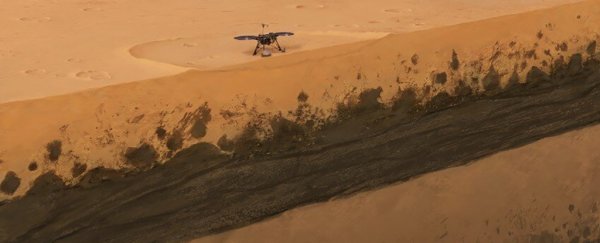Peering deeper below the surface of Earth can tell us a lot about its history and geological make-up, and it's the same for any other planet.
Now the InSight lander on the surface of Mars has provided our first in-depth look at what lies just beneath the red planet's surface.
The seismometer on board InSight – called SEIS or the Seismic Experiment for Interior Structure – points to a shallow sedimentary layer sandwiched between hardened rocks resulting from lava flows, going down to a depth of around 200 meters or about 650 feet.
This could tell us a lot about how Mars was originally formed, how it evolved over time, and the sort of geological factors that are still in play today. In particular, the lava flows can be connected to what we know of the planet's volcanic past.
 (Géraldine Zenhäusern/ETH Zürich)
(Géraldine Zenhäusern/ETH Zürich)
Above: Artist's impression of the InSight lander in the Homestead Hollow, a small impact crater.
"Seismic studies of the shallow subsurface around the InSight landing site so far have been limited to the uppermost 10-20m using seismic-travel time measurements and ground compliance estimates, leaving structures at few tens to several hundreds of meters depth uncharted," the researchers explain in their paper.
InSight arrived on Mars in November 2018, landing in the wide and flat plain known as Elysium Planitia. Here, the lander's instruments measured the slight ambient vibrations of the ground, caused by the winds flowing over the surface of the planet, in order to figure out what was out of view underneath.
The same technique was developed on Earth to assess subsurface composition and the associated earthquake risk. On Mars, the pattern of waves were consistent with two dense layers of rocks, such as basalt, with a thinner, less dense layer of material in the middle, most likely sedimentary in nature.
From what we know about Mars' history from the craters still visible on the planet today, the researchers suggest the uppermost layer of hardened lava is around 1.7 billion years old, formed during the cold, arid Amazonian period on Mars when there were relatively few meteorite and asteroid impacts.
The deeper layer looks to be some 3.6 billion years old, created during the Hesperian period when there was much more volcanic activity on the Red Planet. These ancient periods have molded Mars into the planet that we are seeing and exploring today.
"This helps to tie this to trying to figure out what the timing was between the various different activities," geophysicist Bruce Banerdt, from the Jet Propulsion Laboratory at the California Institute of Technology, told Inverse.
"The fact that you've got this sedimentary layer that is sandwiched between these two volcanic stones tells that there was a pause in the volcanic activity, a fairly long pause because it takes a long time for the sedimentary rocks to form."
The presence of that middle layer, some 30-40 meters (98-131 feet) thick, is something of a surprise for the researchers, and it's not clear exactly what it's made up of or how it was formed. It's possible that there's some mixing with the Amazonian basalts, but the accuracy of the seismic readings decreases at lower depths.
Part of the usefulness of this data lies in working out whether life ever existed on Mars, but it also tells us more about Earth's history and evolution – Earth and Mars are actually pretty similar in terms of geological composition.
Aside from ancient planetary history, there's a more immediate benefit to knowing what's underneath the surface of Mars at different points: It enables scientists to work out the best places to put landers, rovers, and (eventually) space stations in the future.
"While the results help to better understand the geological processes in Elysium Planitia, comparison with pre-landing models is also valuable for future landed missions, since it can help to refine predictions," says seismologist Brigitte Knapmeyer-Endrun from the University of Cologne in Germany.
The research has been published in Nature Communications.
